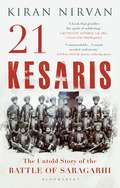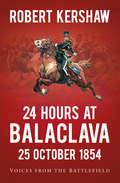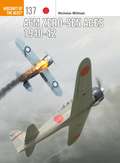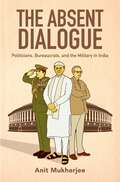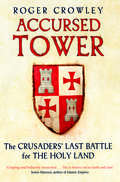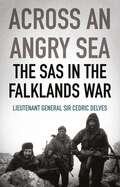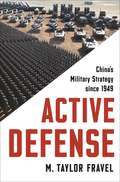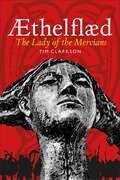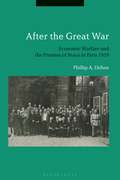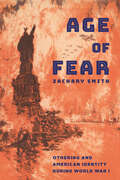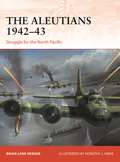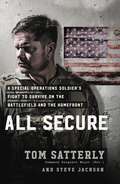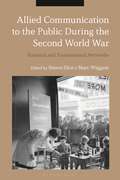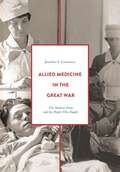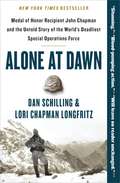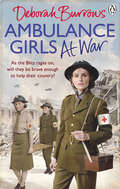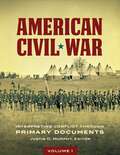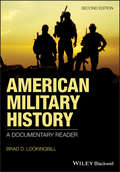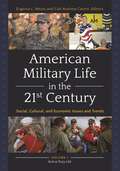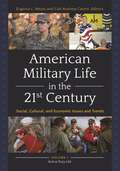- Table View
- List View
21 Kesaris: The Untold Story of the Battle of Saragarhi
by Kiran Nirvan10,000 Afghans. 21 Sikh soldiers. One epic battle. On 12 September 1897, 21 Sikh soldiers of 36th SIKH Regiment stood undeterred as they guarded the post of Saragarhi against the onslaught of almost 10,000 Afghan tribesmen – a battle for the ages that ended in them giving their lives in a final hand-to-hand combat. The unparalleled heroics of these 21 men have, however, been long forgotten by history. What led to the Battle of Saragarhi? What was the socio-political scenario at the time? Who were these tribesmen and why did they attack an outpost with such numerical superiority? Who were the 21 soldiers and how were they able to keep the enemy at bay against all odds? Based on colonial era records and information provided by the 4 Sikh Battalion of Indian Army, the legatee unit of 36th SIKHs, 21 Kesaris attempts to answer these questions while paying homage to the brave soldiers who defended the 'kesari' flag – depicting their Khalsa heritage – with their last breaths.
24 Hours at Balaclava: Voices from the Battlefield
by Robert KershawIN 1854 Britain and France were at war to save ‘poor little Turkey’, the crumbling Ottoman Empire, from the menace of Russian expansionism. On 25 October they were nine days into what would become an eleven-month siege, with little to show for it. Suddenly, from behind them came the unmistakeable sound of cannon. The Russians had arrived. Vastly outnumbered, the British gained an unlikely upper hand with the charge of the Heavy Brigade and the efforts of the Thin Red Line. But then, within two hours of achieving near victory, the British squandered it in dramatic style with the charge of the Light Brigade. Using eyewitness accounts, letters and diaries, acclaimed military historian Robert Kershaw presents a new, intimate look at the Battle of Balaclava, from the perspective of the men who ‘saw little and knew even less’. Come down from the Heights and see the real story of one of the most ill-fated military expeditions in British history.
A6M Zero-sen Aces 1940-42 (Aircraft of the Aces #137)
by Nicholas MillmanThe Mitsubishi A6M Zero-sen was Japan's Spitfire. In continuous development and operational service from the time of the Sino-Japanese war in 1940 to the end of the Pacific War in 1945, it is held in almost mythical awe, similar to Britain's legendary fighter aircraft. At the time of its operational debut the fighter's design features offered the revolutionary combination of an all-round vision canopy, cannon armament and a jettisonable drop tank giving it phenomenal range. Together with the flying and tactical proficiency of superbly trained pilots, this made the Zero-sen a true strategic fighter, spearheading Japan's offensive in the Pacific. It was also the mount of a plethora of successful and flamboyant naval aces engaged in both sea and land campaigns. This volume, the first of two on the A6M Zero-sen, covers the use of the A6M2 variant from its debut in China to the Solomons Campaign, and also tells the story of the A6M2-N "Rufe" floatplane fighter aces.
The Absent Dialogue: Politicians, Bureaucrats, and the Military in India (Modern South Asia)
by Anit MukherjeeCivilian control over the military is widely hailed as one of the major successes of India's democracy. Because it is so rare, especially among post-colonial states, this control is rightfully celebrated. But has this come at a cost? In The Absent Dialogue, Anit Mukherjee argues that the pattern of civil-military relations in India has hampered its military effectiveness. Diving deep into understanding the organization and internal processes within the Indian military, he explains how Indian politicians and bureaucrats have long been content with the formal and ritualistic exercise of civilian control, while the military continues to operate in institutional silos. Yet, there has been little substantive engagement between the two. To support this claim, Mukherjee closely examines the variables most closely associated with military effectiveness-weapons procurement, jointness (the ability of separate military services to operate together), officer education, promotion policies, and defense planning. Further, Mukherjee shows how India's pattern of civil-military relations-best characterized as an absent dialogue-adversely affects each of these processes. While the book focuses on India, it also highlights the importance of civilian expertise and institutional design in enhancing civilian control and military effectiveness in other democracies. Informed by more than a hundred and fifty interviews and recently available archival material, The Absent Dialogue sheds new light on India's military and will reshape our understanding of both the history and contemporary dynamics of civil-military relations and recurring problems therein.
Accursed Tower: The Crusaders' Last Battle for the Holy Land
by Roger CrowleyThe city of Acre, powerfully fortified and richly provisioned, was the last crusader stronghold. When it fell in 1291, two hundred years of Christian crusading in the Holy Land came to a bloody end. With his customary narrative brilliance and immediacy, Roger Crowley chronicles the tumultuous and violent attack on Acre, the heaviest bombardment before the age of gunpowder, which left this once great Mediterranean city a crumbling ruin. The ‘Accursed Tower’ was the focal point of this siege. As the last garrison of the Crusader defences, it came to symbolise the disintegration of the old world and the rise of a new era of Islamic jihad. Crowley’s narrative is based on forensic research, drawing heavily on little known first hand sources, both Christian and Arabic. This is a fast-paced and gripping account of a pivotal moment in world history.
Across an Angry Sea: The SAS in the Falklands War
by Cedric DelvesIn early summer 1982--winter in the South Atlantic--Argentina's military junta invades the Falklands. Within days, a British Royal Navy Task Force is assembled and dispatched. This is the story of D Squadron, 22 SAS, commanded by Cedric Delves. The relentless tempo of events defies belief. Raging seas, inhospitable glaciers, hurricane-force winds, helicopter crashes, raids behind enemy lines--the Squadron prevailed against them all, but the cost was high. Eight died and more were wounded or captured. Holding fast to their humanity, D Squadron's fighters were there at the start and end of the Falklands War, the first to raise a Union Jack over Government House in Stanley. Across an Angry Sea is a chronicle of daring, skill and steadfastness among a tight-knit band of brothers; of going awry, learning fast, fighting hard, and winning through.
Active Defense: China's Military Strategy since 1949 (Princeton Studies in International History and Politics #167)
by M. Taylor FravelWhat changes in China’s modern military policy reveal about military organizations and strategySince the 1949 Communist Revolution, China has devised nine different military strategies, which the People’s Liberation Army (PLA) calls “strategic guidelines.” What accounts for these numerous changes? Active Defense offers the first systematic look at China’s military strategy from the mid-twentieth century to today. Exploring the range and intensity of threats that China has faced, M. Taylor Fravel illuminates the nation’s past and present military goals and how China sought to achieve them, and offers a rich set of cases for deepening the study of change in military organizations.Drawing from diverse Chinese-language sources, including memoirs of leading generals, military histories, and document collections that have become available only in the last two decades, Fravel shows why transformations in military strategy were pursued at certain times and not others. He focuses on the military strategies adopted in 1956, 1980, and 1993—when the PLA was attempting to wage war in a new kind of way—to show that China has pursued major change in its strategic guidelines when there has been a significant shift in the conduct of warfare in the international system and when China’s Communist Party has been united.Delving into the security threats China has faced over the last seven decades, Active Defense offers a detailed investigation into how and why states alter their defense policies.
Active Defense: China's Military Strategy since 1949 (Princeton Studies in International History and Politics #167)
by M. Taylor FravelWhat changes in China’s modern military policy reveal about military organizations and strategySince the 1949 Communist Revolution, China has devised nine different military strategies, which the People’s Liberation Army (PLA) calls “strategic guidelines.” What accounts for these numerous changes? Active Defense offers the first systematic look at China’s military strategy from the mid-twentieth century to today. Exploring the range and intensity of threats that China has faced, M. Taylor Fravel illuminates the nation’s past and present military goals and how China sought to achieve them, and offers a rich set of cases for deepening the study of change in military organizations.Drawing from diverse Chinese-language sources, including memoirs of leading generals, military histories, and document collections that have become available only in the last two decades, Fravel shows why transformations in military strategy were pursued at certain times and not others. He focuses on the military strategies adopted in 1956, 1980, and 1993—when the PLA was attempting to wage war in a new kind of way—to show that China has pursued major change in its strategic guidelines when there has been a significant shift in the conduct of warfare in the international system and when China’s Communist Party has been united.Delving into the security threats China has faced over the last seven decades, Active Defense offers a detailed investigation into how and why states alter their defense policies.
Active Defense: China's Military Strategy since 1949 (Princeton Studies in International History and Politics #167)
by M. Taylor FravelWhat changes in China’s modern military policy reveal about military organizations and strategySince the 1949 Communist Revolution, China has devised nine different military strategies, which the People’s Liberation Army (PLA) calls “strategic guidelines.” What accounts for these numerous changes? Active Defense offers the first systematic look at China’s military strategy from the mid-twentieth century to today. Exploring the range and intensity of threats that China has faced, M. Taylor Fravel illuminates the nation’s past and present military goals and how China sought to achieve them, and offers a rich set of cases for deepening the study of change in military organizations.Drawing from diverse Chinese-language sources, including memoirs of leading generals, military histories, and document collections that have become available only in the last two decades, Fravel shows why transformations in military strategy were pursued at certain times and not others. He focuses on the military strategies adopted in 1956, 1980, and 1993—when the PLA was attempting to wage war in a new kind of way—to show that China has pursued major change in its strategic guidelines when there has been a significant shift in the conduct of warfare in the international system and when China’s Communist Party has been united.Delving into the security threats China has faced over the last seven decades, Active Defense offers a detailed investigation into how and why states alter their defense policies.
Aethelflaed: The Lady of the Mercians
by Tim ClarksonAt the end of the ninth century AD, a large part of what is now England was controlled by the Vikings – heathen warriors from Scandinavia who had been attacking the British Isles for more than a hundred years. Alfred the Great, king of Wessex, was determined to regain the conquered lands but his death in 899 meant that the task passed to his son Edward. In the early 900s, Edward led a great fightback against the Viking armies. He was assisted by the English rulers of Mercia: Lord Æthelred and his wife Æthelflæd (Edward’s sister).After her husband’s death, Æthelflæd ruled Mercia on her own, leading the army to war and working with her brother to achieve their father’s aims. Known to history as the Lady of the Mercians, she earned a reputation as a competent general and was feared by her enemies. She helped to save England from the Vikings and is one of the most famous women of the Dark Ages. This book, published 1100 years after her death, tells her remarkable story.
After the Great War: Economic Warfare and the Promise of Peace in Paris 1919
by Phillip DehneAt the Paris Peace Conference of 1919, the international community came together to find a way forward in the aftermath of the First World War. The conference is often judged a failure, as the resulting Treaty of Versailles did not bring long-term peace with Germany. By following the activities of British delegate and wartime Minister of Blockade Lord Robert Cecil, this book examines the struggles and successes of the conference, as delegates from around the world grappled with the economic, political and humanitarian catastrophes overwhelming Europe in 1919. After the Great War describes, for the first time, the significant role of economic warfare at the Peace Conference and in the post-war settlement. Lord Cecil's sometimes difficult partnership with US President Woodrow Wilson forged a new, permanent, international diplomatic organization – the League of Nations – and supplied it with the power to create collective blockades against aggressive states. Leaders of the Allied economic war before the Armistice became, in Paris, leaders of humanitarian-minded international outreach to their former enemies in Germany and Austria. After the Great War promotes a new understanding of these underappreciated internationalists in Paris, many of whom transitioned into leading the League of Nations even before the Peace Conference ended. Often derided as an idealistic fantasy, international peace enforced by economic sanctions appeared a realistic possibility when the Treaty was signed at the end of June 1919.
Age of Fear: Othering and American Identity during World War I
by Zachary SmithAlthough Americans have long celebrated their nation's diversity, they also have consistently harbored suspicions of foreign peoples both at home and abroad. In Age of Fear, Zachary Smith argues that, as World War I grew more menacing and the presumed German threat loomed over the United States, many white "Anglo-Saxon" Americans grew increasingly concerned about the vulnerability of their race, culture, and authority. Consequently, they directed their long-held apprehensions over ethnic and racial pluralism onto their German neighbors and overseas enemies whom they had once greatly admired.Smith examines the often racially tinged, apocalyptic arguments made during the war by politicians, propaganda agencies, the press, novelists, and artists. He also assesses citizens' reactions to these messages and explains how the rise of nationalism in the United States and Europe acted as a catalyst to hierarchical racism. Germans in both the United States and Europe eventually took the form of the proverbial "Other," a dangerous, volatile, and uncivilized people who posed an existential threat to the nation and all that Anglo-Saxon Americans believed themselves to be. Exploring what the Great War meant to a large portion of the white American population while providing a historic precedent for modern-day conceptions of presumably dangerous foreign Others, Age of Fear is a compelling look at how the source of wartime paranoia can be found in deep-seated understandings of racial and millennial progress.
Age of Fear: Othering and American Identity during World War I
by Zachary SmithAlthough Americans have long celebrated their nation's diversity, they also have consistently harbored suspicions of foreign peoples both at home and abroad. In Age of Fear, Zachary Smith argues that, as World War I grew more menacing and the presumed German threat loomed over the United States, many white "Anglo-Saxon" Americans grew increasingly concerned about the vulnerability of their race, culture, and authority. Consequently, they directed their long-held apprehensions over ethnic and racial pluralism onto their German neighbors and overseas enemies whom they had once greatly admired.Smith examines the often racially tinged, apocalyptic arguments made during the war by politicians, propaganda agencies, the press, novelists, and artists. He also assesses citizens' reactions to these messages and explains how the rise of nationalism in the United States and Europe acted as a catalyst to hierarchical racism. Germans in both the United States and Europe eventually took the form of the proverbial "Other," a dangerous, volatile, and uncivilized people who posed an existential threat to the nation and all that Anglo-Saxon Americans believed themselves to be. Exploring what the Great War meant to a large portion of the white American population while providing a historic precedent for modern-day conceptions of presumably dangerous foreign Others, Age of Fear is a compelling look at how the source of wartime paranoia can be found in deep-seated understandings of racial and millennial progress.
The Aleutians 1942–43: Struggle for the North Pacific (Campaign)
by Brian Lane HerderIt is often forgotten that during World War II, the Japanese managed to successfully invade and conquer a precious part of American home soil – the first time this had happened since 1815. Capturing the Aleutian Islands, located in Alaska territory, was seen by the Japanese as vital in order to shore up their northern defensive perimeter. Fighting in the Aleutians was uniquely brutal. It is a barren, rugged archipelago of icy mountains and thick bogs, with a climate of constant snow, freezing rains and windstorms. These geographic conditions tended to neutralize traditional American strengths such as air power, radar, naval bombardment and logistics. The campaign to recapture the islands required extensive combined-ops planning, and inflicted on the United States its second highest casualty rate in the Pacific theatre. Featuring the largest Japanese banzai charge of the war, first use of pre-battle battleship bombardment in the Pacific and the battle at the Komandorski Islands, this is the full story of the forgotten battle to liberate American soil from the Japanese.
All Secure: A Special Operations Soldier's Fight to Survive on the Battlefield and the Homefront
by Steve Jackson Tom SatterlyOne of the most highly regarded special operations soldiers in American military history shares his war stories and personal battle with PTSD.As a senior non-commissioned officer of the most elite and secretive special operations unit in the U.S. military, Command Sergeant Major Tom Satterly fought some of this country's most fearsome enemies. Over the course of twenty years and thousands of missions, he's fought desperately for his life, rescued hostages, killed and captured terrorist leaders, and seen his friends maimed and killed around him. All Secure is in part Tom's journey into a world so dark and dangerous that most Americans can't contemplate its existence. It recounts what it is like to be on the front lines with one of America's most highly trained warriors. As action-packed as any fiction thriller, All Secure is an insider's view of "The Unit." Tom is a legend even among other Tier One special operators. Yet the enemy that cost him three marriages, and ruined his health physically and psychologically, existed in his brain. It nearly led him to kill himself in 2014; but for the lifeline thrown to him by an extraordinary woman it might have ended there. Instead, they took on Satterly's most important mission-saving the lives of his brothers and sisters in arms who are killing themselves at a rate of more than twenty a day. Told through Satterly's firsthand experiences, it also weaves in the reasons-the bloodshed, the deaths, the intense moments of sheer terror, the survivor's guilt, depression, and substance abuse-for his career-long battle against the most insidious enemy of all: Post Traumatic Stress. With the help of his wife, he learned that by admitting his weaknesses and faults he sets an example for other combat veterans struggling to come home.
All the Flowers in Paris: The most heartbreaking new WW2 novel from international bestselling author you'll read this year
by Sarah JioLove burns brightest in the darkest timesWhen Caroline Williams wakes up in Paris with no memory of her past, she finds that returning to the life she has forgotten is harder than she thought. Even her cavernous apartment on rue Cler seems to hold no clues...As she searches, Caroline discovers a hidden stack of letters written by a young mother, Céline, during the Second World War. Captivated by Céline's desperate love for both her daughter and her missing lover, and the haunting glimpses of Paris under Nazi occupation, Caroline begins to realise she may have more in common with Céline that she could ever imagine.What dark secrets are harboured within the walls of her picture-perfect Parisian home? And could uncovering the truth about Céline unlock Caroline's own...?The compelling and evocative new historical novel from the international bestselling author Sarah Jio. Perfect for fans of The Key by Kathryn Hughes, The Parisians by Marius Gabriel and The Paris Secret by Lily Graham.
Allied Communication to the Public During the Second World War: National and Transnational Networks
by Simon Eliot Marc WiggamIn the Second World War, the home fronts of many countries became as important as the battle fronts. As governments tried to win and hold the trust of domestic and international audiences, communication became central to their efforts. This volume offers cutting-edge research by leading and emerging scholars on how information was used, distributed and received during the war. With a transnational approach encompassing Germany, Iberia, the Arab world and India, it demonstrates that the Second World War was as much a war of ideas and influence as one of machines and battles.Simon Eliot, Marc Wiggam and the contributors address the main communication problems faced by Allied governments, including how to balance the free exchange of information with the demands of national security and wartime alliances, how to frame war aims differently for belligerent, neutral and imperial audiences and how to represent effectively a variety of communities in wartime propaganda. In doing so, they reveal the contested and transnational character of the ways in which information was conveyed during the Second World War.Allied Communication during the Second World War offers innovative and nuanced perspectives on the thin border between information and propaganda during this global war and will be vital reading for World War II and media historians alike.
Allied Medicine in the Great War: The Medical Front and the People Who Fought
by Jennifer S. LawrenceThis book provides an overview of the history of allied medicine in the Great War. Based on both primary research and secondary literature, it offers a clear and concise account of medical treatment during the Great War, exploring the advancements of the period and the human experience of the medical war.As well as covering European medical work, the book draws on a range of American primary sources and texts in order to address the American medical experience of the First World War, an area that has been neglected by the existing literature.This is an accessible exploration of the medical war, the people involved, and its impact. It is an essential text for undergraduate and postgraduate students of History taking courses on medicine in war, the history of medicine or the Great War.
Allied Medicine in the Great War: The Medical Front and the People Who Fought
by Jennifer S. LawrenceThis book provides an overview of the history of allied medicine in the Great War. Based on both primary research and secondary literature, it offers a clear and concise account of medical treatment during the Great War, exploring the advancements of the period and the human experience of the medical war.As well as covering European medical work, the book draws on a range of American primary sources and texts in order to address the American medical experience of the First World War, an area that has been neglected by the existing literature.This is an accessible exploration of the medical war, the people involved, and its impact. It is an essential text for undergraduate and postgraduate students of history taking courses on medicine in war, the history of medicine or the Great War.
Alone at Dawn: Medal of Honor Recipient John Chapman and the Untold Story of the World's Deadliest Special Operations Force
by Dan Schilling Lori LongfritzThe New York Times bestselling true account of John Chapman, Medal of Honor recipient and Special Ops Combat Controller, and his heroic one-man stand during the Afghan War, as he sacrificed his life to save the lives of twenty-three comrades-in-arms.In the predawn hours of March 4, 2002, just below the 10,469-foot peak of a mountain in eastern Afghanistan, a fierce battle raged. Outnumbered by Al Qaeda fighters, Air Force Combat Controller John Chapman and a handful of Navy SEALs struggled to take the summit in a desperate bid to find a lost teammate.Chapman, leading the charge, was gravely wounded in the initial assault. Believing he was dead, his SEAL leader ordered a retreat. Chapman regained consciousness alone, with the enemy closing in on three sides.John Chapman's subsequent display of incredible valor -- first saving the lives of his SEAL teammates and then, knowing he was mortally wounded, single-handedly engaging two dozen hardened fighters to save the lives of an incoming rescue squad -- posthumously earned him the Medal of Honor. Chapman is the first airman in nearly fifty years to be given the distinction reserved for America's greatest heroes.Alone at Dawn is also a behind-the-scenes look at the Air Force Combat Controllers: the world's deadliest and most versatile special operations force, whose members must not only exceed the qualifications of Navy SEAL and Army Delta Force teams but also act with sharp decisiveness and deft precision -- even in the face of life-threatening danger.Drawing from firsthand accounts, classified documents, dramatic video footage, and extensive interviews with leaders and survivors of the operation, Alone at Dawn is the story of an extraordinary man's brave last stand and the brotherhood that forged him.
Ambulance Girls At War
by Deborah BurrowsYoung Maisie Halliday has escaped the grinding poverty of the northern town where she was born to live in the glittering world of professional dancing. At the outbreak of the Second World War, she volunteers as an ambulance driver, finding joy both in helping the wounded during the Blitz and also in her friends among the other drivers in the Bloomsbury Auxiliary Ambulance Depot. Maisie is at the Cafe de Paris nightclub when it is bombed. In the chaos, she attempts to help an injured man, and by this charitable act she becomes mixed up in what may well be a murder. A series of incidents, all connected to a handsome, arrogant American, throw Maisie's life into a dangerous spin. Is anything what it seems in wartime? With one serious misjudgement, Maisie risks losing everything she holds dear...
American Civil War [2 volumes]: Interpreting Conflict through Primary Documents [2 volumes]
by Justin D. MurphyBy providing detailed analyses of Civil War primary sources, this book will help readers to understand the history of the bloodiest of all American conflicts.This meticulously curated collection of primary source documents covers every aspect of the American Civil War, from its origins to its bloody engagements, all the way through the Reconstruction period. With approximately 300 primary sources, this comprehensive set includes orders and reports of significant battles, political debates and speeches, legislation, court cases, and literary works from the Civil War era. The documents provide insight into the thinking of all participants, drawing upon a vast range of sources that offer both a Northern and Southern perspective.The book gives equal treatment to the Eastern and Western Theaters and to Union and Confederate sources, and the primary sources are presented in chronological order, making it easy for readers to compare and contrast documents as the key events of the conflict unfold. Each primary source begins with an introduction that sets the document in its proper context and concludes with an analysis of the document that will help students to understand the document's significance.
American Military History: A Documentary Reader
by Brad D. LookingbillA collection of primary documents that explore the many facets of the American military from the colonial period to the present The second edition of American Military History offers an exceptional collection of primary documents relating to history of the military of the United States from 1607 through the present. The writings offer insight into the armed forces in relation to the social, cultural, economic, political, and territorial development of the United States. Several documents comment on strategic initiatives, combat operations, force structure, public policy, and home fronts. The writings also present firsthand testimony of extraordinary men and women in uniform and most of the documents explore the connections between combatants and the societies that produced them. From the beginnings of the war against the natives through the tragedy of the Civil War and up to the current Global War on Terror, American Military History offers a chronological account of the evolution of the United States military. This vital text: Includes writings that explore the diversity of the armed forces Explores leadership in America’s military affairs Traces America’s ways of war beginning in 1607 through the present Examines the patterns of design and purpose of the American military over time Reveals the vitality of civil-military relations in the United States Written for academics and students of military history, American Military History is an important text that draws on primary sources to explore the many facets of America’s military history.
American Military Life in the 21st Century [2 volumes]: Social, Cultural, and Economic Issues and Trends [2 volumes]
by Eugenia L. Weiss Carl Andrew CastroA comprehensive guide to the lives and experiences of military service members, veterans, and their families in the United States today, with special emphasis given to those of the post-9/11 era.This reference work provides detailed information on the issues U.S. service members face both stateside and during deployments overseas. Issues covered include relations with family; substance use; housing; educational and job training opportunities; post-traumatic stress disorder and other health issues; and experiences of women, sexual minorities, and ethnic/racial minorities in the armed services. This set also examines major issues related to military service for people close to the men and women who serve our country, such as spouses or partners, children, and parents grappling with such issues as single parenthood during deployment and bereavement at the loss of a loved one. Finally, this set is a valuable resource for people seeking a greater understanding of the issues that confront some military service members and veterans, from chronic health problems to economic vulnerability to suicide to incarceration. The two volumes are written in a comprehensive yet succinct and accessible style by experts familiar with the latest trends and findings.
American Military Life in the 21st Century [2 volumes]: Social, Cultural, and Economic Issues and Trends [2 volumes]
by Eugenia L. Weiss and Carl Andrew CastroA comprehensive guide to the lives and experiences of military service members, veterans, and their families in the United States today, with special emphasis given to those of the post-9/11 era.This reference work provides detailed information on the issues U.S. service members face both stateside and during deployments overseas. Issues covered include relations with family; substance use; housing; educational and job training opportunities; post-traumatic stress disorder and other health issues; and experiences of women, sexual minorities, and ethnic/racial minorities in the armed services. This set also examines major issues related to military service for people close to the men and women who serve our country, such as spouses or partners, children, and parents grappling with such issues as single parenthood during deployment and bereavement at the loss of a loved one. Finally, this set is a valuable resource for people seeking a greater understanding of the issues that confront some military service members and veterans, from chronic health problems to economic vulnerability to suicide to incarceration. The two volumes are written in a comprehensive yet succinct and accessible style by experts familiar with the latest trends and findings.
